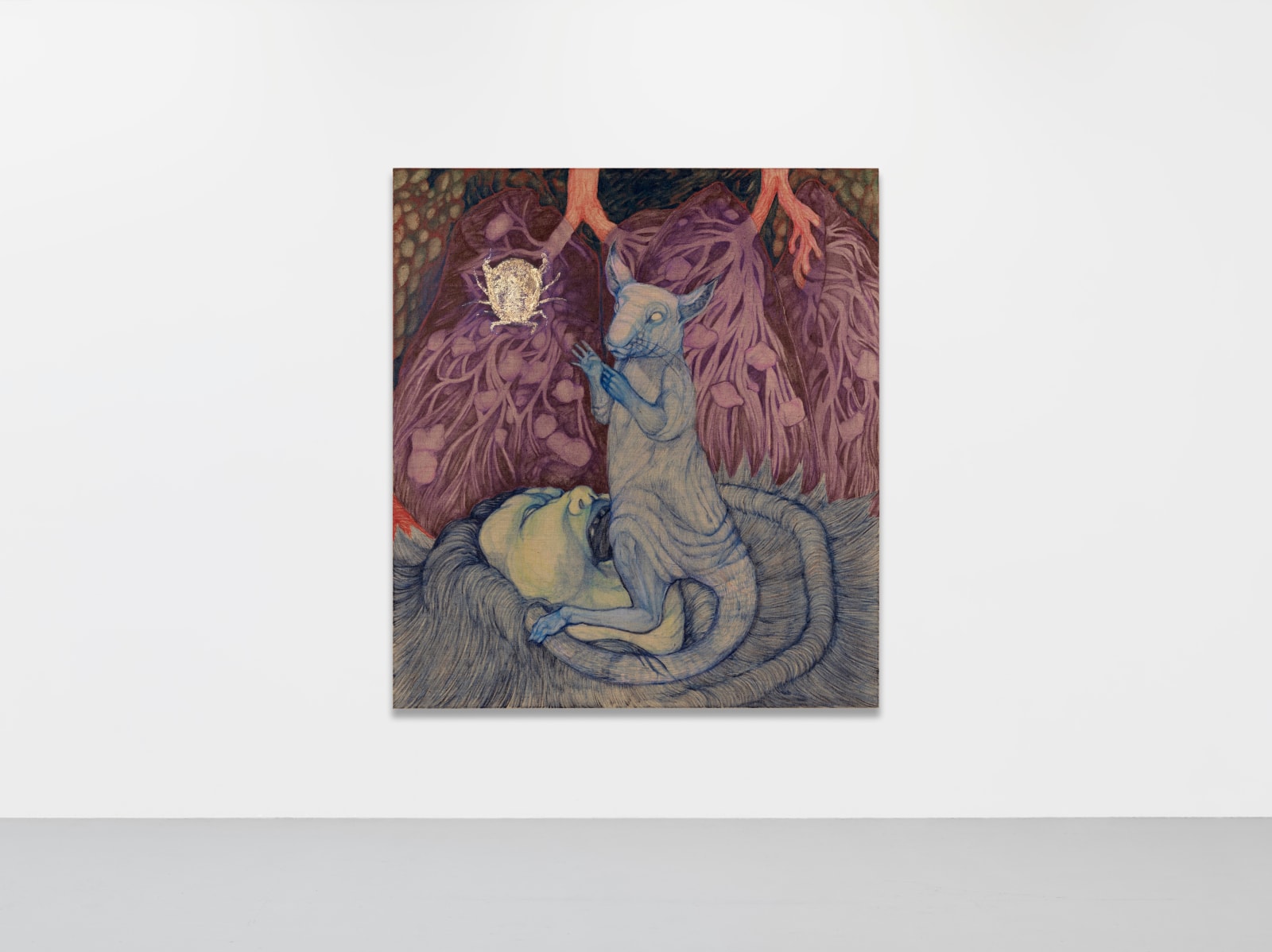Victor Bengtsson
OncoMouse, 2022
oil and gold leaf on jute
200 x 180 cm
78 3/4 x 70 7/8 in
78 3/4 x 70 7/8 in
In 1983 as part of research on cancer treatments at Harvard, geneticists Philip Leder and Timothy Steward introduced an oncogene which allows uncontrollable cancer growth in a mouse using a...
In 1983 as part of research on cancer treatments at Harvard, geneticists Philip Leder and Timothy Steward introduced an oncogene which allows uncontrollable cancer growth in a mouse using a recombinant DNA technique, making it highly prone to developing cancer and passing on this trait to its offspring. This manipulation in the cells of the mouse created a new species which they called “the Harvard Mouse” and was later patented by the DuPont medical company that funded the research as the Oncomouse (onco being a prefix for ‘tumour’ or ‘mass’ in reference to cancer). It was the first vertebrate species to be patented by a company and acts as living proof of the need for ‘bare life’ to experiment on in the modern medical industrial complex – the invention and patenting of a new species whose sole intended purpose is to be a test subject.
Donna Haraway’s writings about the figure of the Oncomouse as a surrogate for human suffering has been a key reference for Bengtsson: “OncoMouseTM is my sibling, and more properly, male or female, s/he is my sister... Although her promise is decidedly secular, s/he is a figure in the sense developed within Christian realism: s/he is our scapegoat; s/he bears our suffering; s/he signifies and enacts our mortality in a powerful, historically specific way that promises a culturally privileged kind of secular salvation—a ‘cure for cancer’” (Haraway, 1997: 79). The painting represents a specimen of Oncomouse standing on its back legs like a martyr in the foreground while stepping on a sickly human face, with its long tail tucking itself into the hair. The background of the painting shows a pair of lungs that are afflicted with a severely metastasised cancer and brings forth the relation between the two figures: a new form of life destined to suffer from this terrible illness in order to develop treatments for human bodies.
Bibliography:
-Haraway, D. (1997) Modest_Witness@Second_Millenium.FemaleMan_Meets_OncoMouse, Routledge: New York, London
Donna Haraway’s writings about the figure of the Oncomouse as a surrogate for human suffering has been a key reference for Bengtsson: “OncoMouseTM is my sibling, and more properly, male or female, s/he is my sister... Although her promise is decidedly secular, s/he is a figure in the sense developed within Christian realism: s/he is our scapegoat; s/he bears our suffering; s/he signifies and enacts our mortality in a powerful, historically specific way that promises a culturally privileged kind of secular salvation—a ‘cure for cancer’” (Haraway, 1997: 79). The painting represents a specimen of Oncomouse standing on its back legs like a martyr in the foreground while stepping on a sickly human face, with its long tail tucking itself into the hair. The background of the painting shows a pair of lungs that are afflicted with a severely metastasised cancer and brings forth the relation between the two figures: a new form of life destined to suffer from this terrible illness in order to develop treatments for human bodies.
Bibliography:
-Haraway, D. (1997) Modest_Witness@Second_Millenium.FemaleMan_Meets_OncoMouse, Routledge: New York, London
Assine nossa newsletter
Campos Requeridos
We will process the personal data you have supplied to communicate with you in accordance with our Política de Privacidade. Você pode cancelar a assinatura ou alterar suas preferências a qualquer momento, clicando no link em nossos e-mails.
